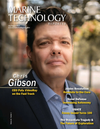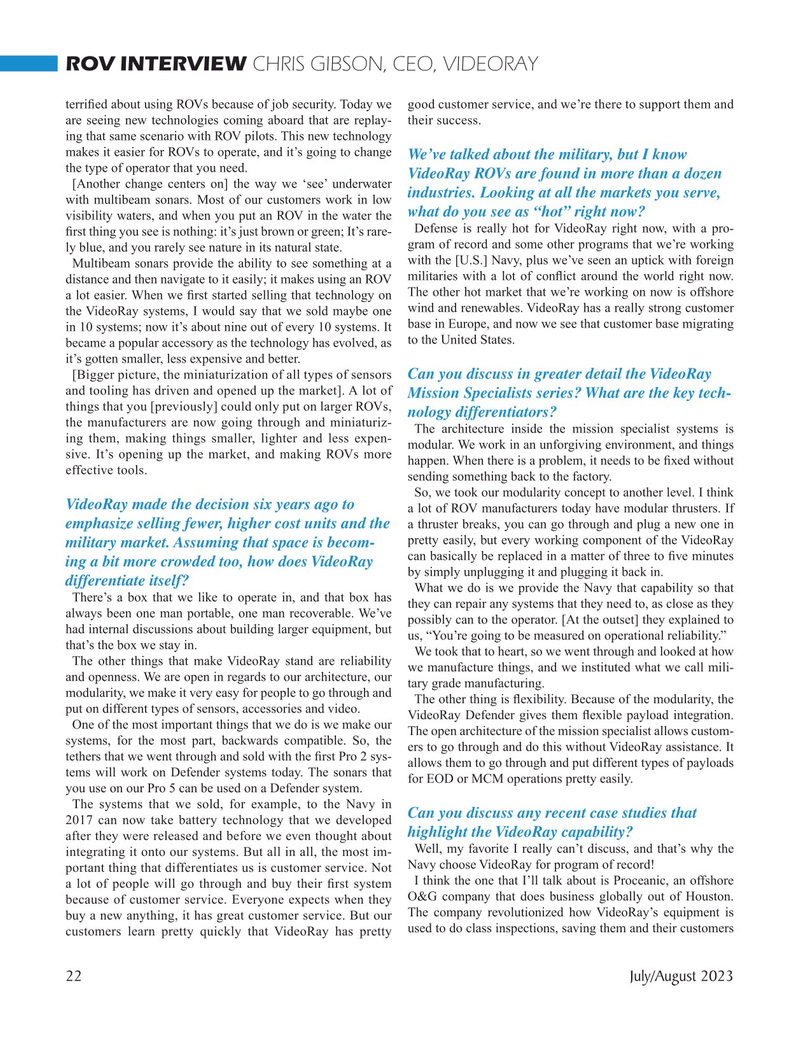
Page 22: of Marine Technology Magazine (July 2023)
Read this page in Pdf, Flash or Html5 edition of July 2023 Marine Technology Magazine
ROV INTERVIEW CHRIS GIBSON, CEO, VIDEORAY terri? ed about using ROVs because of job security. Today we good customer service, and we’re there to support them and are seeing new technologies coming aboard that are replay- their success.
ing that same scenario with ROV pilots. This new technology makes it easier for ROVs to operate, and it’s going to change
We’ve talked about the military, but I know the type of operator that you need.
VideoRay ROVs are found in more than a dozen [Another change centers on] the way we ‘see’ underwater industries. Looking at all the markets you serve, with multibeam sonars. Most of our customers work in low what do you see as “hot” right now?
visibility waters, and when you put an ROV in the water the
Defense is really hot for VideoRay right now, with a pro- ? rst thing you see is nothing: it’s just brown or green; It’s rare- gram of record and some other programs that we’re working ly blue, and you rarely see nature in its natural state.
Multibeam sonars provide the ability to see something at a with the [U.S.] Navy, plus we’ve seen an uptick with foreign distance and then navigate to it easily; it makes using an ROV militaries with a lot of con? ict around the world right now. a lot easier. When we ? rst started selling that technology on The other hot market that we’re working on now is offshore the VideoRay systems, I would say that we sold maybe one wind and renewables. VideoRay has a really strong customer in 10 systems; now it’s about nine out of every 10 systems. It base in Europe, and now we see that customer base migrating became a popular accessory as the technology has evolved, as to the United States.
it’s gotten smaller, less expensive and better.
Can you discuss in greater detail the VideoRay [Bigger picture, the miniaturization of all types of sensors and tooling has driven and opened up the market]. A lot of
Mission Specialists series? What are the key tech- things that you [previously] could only put on larger ROVs, nology differentiators?
the manufacturers are now going through and miniaturiz-
The architecture inside the mission specialist systems is ing them, making things smaller, lighter and less expen- modular. We work in an unforgiving environment, and things sive. It’s opening up the market, and making ROVs more happen. When there is a problem, it needs to be ? xed without effective tools.
sending something back to the factory.
So, we took our modularity concept to another level. I think
VideoRay made the decision six years ago to a lot of ROV manufacturers today have modular thrusters. If emphasize selling fewer, higher cost units and the a thruster breaks, you can go through and plug a new one in pretty easily, but every working component of the VideoRay military market. Assuming that space is becom- can basically be replaced in a matter of three to ? ve minutes ing a bit more crowded too, how does VideoRay by simply unplugging it and plugging it back in.
differentiate itself?
What we do is we provide the Navy that capability so that
There’s a box that we like to operate in, and that box has they can repair any systems that they need to, as close as they always been one man portable, one man recoverable. We’ve possibly can to the operator. [At the outset] they explained to had internal discussions about building larger equipment, but us, “You’re going to be measured on operational reliability.” that’s the box we stay in.
We took that to heart, so we went through and looked at how
The other things that make VideoRay stand are reliability we manufacture things, and we instituted what we call mili- and openness. We are open in regards to our architecture, our tary grade manufacturing. modularity, we make it very easy for people to go through and
The other thing is ? exibility. Because of the modularity, the put on different types of sensors, accessories and video.
VideoRay Defender gives them ? exible payload integration.
One of the most important things that we do is we make our
The open architecture of the mission specialist allows custom- systems, for the most part, backwards compatible. So, the ers to go through and do this without VideoRay assistance. It tethers that we went through and sold with the ? rst Pro 2 sys- allows them to go through and put different types of payloads tems will work on Defender systems today. The sonars that for EOD or MCM operations pretty easily.
you use on our Pro 5 can be used on a Defender system.
The systems that we sold, for example, to the Navy in
Can you discuss any recent case studies that 2017 can now take battery technology that we developed highlight the VideoRay capability?
after they were released and before we even thought about
Well, my favorite I really can’t discuss, and that’s why the integrating it onto our systems. But all in all, the most im- portant thing that differentiates us is customer service. Not Navy choose VideoRay for program of record!
I think the one that I’ll talk about is Proceanic, an offshore a lot of people will go through and buy their ? rst system because of customer service. Everyone expects when they O&G company that does business globally out of Houston. buy a new anything, it has great customer service. But our The company revolutionized how VideoRay’s equipment is customers learn pretty quickly that VideoRay has pretty used to do class inspections, saving them and their customers 22 July/August 2023
MTR #5 (18-33).indd 22 7/24/2023 8:57:38 AM

 21
21

 23
23
